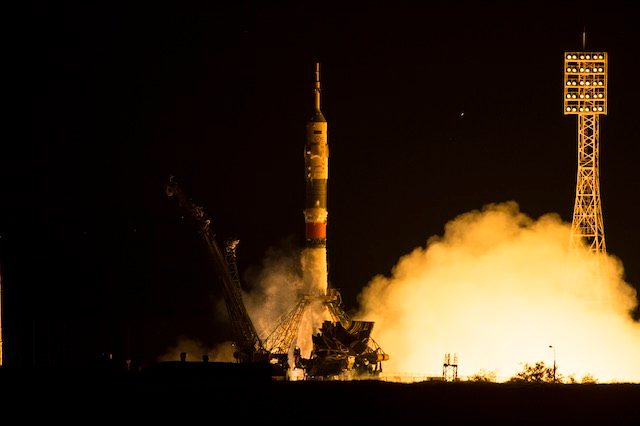SUMMARY
This is AI generated summarization, which may have errors. For context, always refer to the full article.

BAIKONUR, Kazakhstan (UPDATED) – Astronauts from Russia, Japan and the United States Thursday, July 23, docked successfully with the International Space Station under 6 hours after they launched, NASA television showed.
The Soyuz TMA 17M rocket – carrying cosmonaut Oleg Kononenko, US astronaut Kjell Lindgren and Kimiya Yui of Japan – had roared skyward from Russia’s Baikonur cosmodrome in the barren Kazakh steppe at 2102 GMT.
After a fly-around at around 350 meters (1,150 feet), the rocket maneuvered to rendezvous with the ISS at 10:46 US Eastern time Wednesday, July 22 (0246 GMT Thursday).
“We have contact,” a NASA announcer said, as the craft soared high above the coast of Ecuador, 402 kilometers (250 miles) over the Pacific.
One solar array – a type of power supply that captures energy from the sun – did not deploy on time, but this did not affect the rocket’s flight as the others were still operating, the US space agency said.
Scientists and space enthusiasts around the world were watching the launch closely, and with some concern, since the mission had been delayed by two months because of a Russian rocket failure.
Russia was in May forced to put all space travel on hold after the unmanned Progress freighter taking cargo to the ISS crashed back to Earth in late April.
The doomed ship lost contact with Earth and burned up in the atmosphere. The failure, which Russia has blamed on a problem in a Soyuz rocket, also forced a group of astronauts to spend an extra month aboard the ISS.
Russian officials earlier breathed a sigh of relief, with the space agency Roscosmos saying that the third stage of the Soyuz rocket separated on time and the crew were “feeling well”.
“Everything is okay, everything is according to plan,” said veteran cosmonaut Fyodor Yurchikhin, providing live commentary of the liftoff on television.
A workhorse of space that dates back to the Cold War, the Soyuz is used for manned and unmanned flights.
“Training… check. Equipment… check. Rocket… check. Press conference… check. We are ready to fly!!” 42-year-old Lindgren said on Twitter before the liftoff.
Japan’s Yui, 45, is now the 10th Japanese astronaut to have travelled in space.
Ahead of the launch, the 3 men met with 81-year-old cosmonaut Alexei Leonov, the first man to walk in space and one of the Apollo-Soyuz commanders.
Sending the first man into space in 1961 and launching the first Sputnik satellite four years earlier are among key accomplishments of the Russian space program and remain a major source of national pride in the country.
But over the past few years, Russia has suffered several major setbacks, notably losing expensive satellites and unmanned supply ships to the ISS.
NASA has funneled $4.2 billion to Boeing and $2.6 billion to SpaceX to help the companies build a successor to the space shuttle and to encourage competition in the aerospace industry.
In the meantime, the world’s astronauts fly to the ISS aboard Russian Soyuz spaceships at a cost of $70 million per seat. – Rappler.com
Add a comment
How does this make you feel?
There are no comments yet. Add your comment to start the conversation.